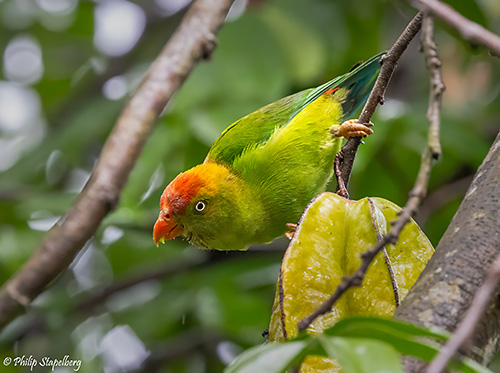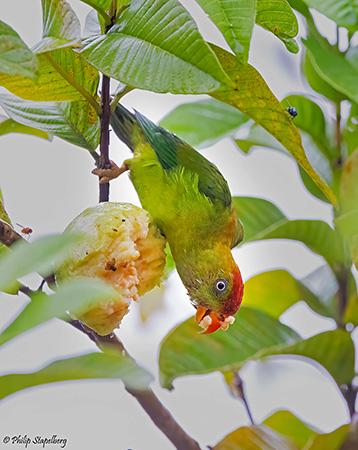Fr: Coryllis de Ceylan
Ang: Sri Lanka Hanging Parrot - Ceylon Hanging-Parrot
All: Ceylonpapageichen
Esp: Lorículo de Ceilán
Ita: Coryllis de Ceylan
Nd: Ceylonese Vleermuisparkiet
Sd: ceylonhängpapegoja
Photographers:
Steve Garvie
RAINBIRDER Photo galleries
Philip Stapelberg
GALLERY
Alan & Ann Tate
AA Bird Photography
Text by Nicole Bouglouan
Sources:
HANDBOOK OF THE BIRDS OF THE WORLD vol 4 by Josep del Hoyo-Andrew Elliott-Jordi Sargatal - Lynx Edicions - ISBN: 8487334229
PARROTS OF THE WORLD – An Identification Guide – by Joseph M. Forshaw – Princeton University Press – ISBN 0691092516
Sri Lanka Hanging parrot - Loriculus beryllinus - Endemic to Sri Lanka
Wikipedia, the free encyclopaedia
Sri Lanka Hanging Parrot or Ceylon Hanging-Parrot
Loriculus beryllinus
Psittaciformes Order – Psittaculidae Family
INTRODUCTION:
The Sri Lanka Hanging Parrot or Ceylon Hanging-Parrot is endemic to Sri Lanka and mostly present in the southwest of the island. It is found in the central hills, up to 1,400 metres of elevation, sometimes higher outside the breeding season.
The species is more often seen in the lower hills and the wet zone, and it is less present in the dry zone regions close to the hills.
It feeds on nectar and juicy fruits while scrambling along tree branches with agility. It is frequently observed in orchards and gardens with fruiting trees.
The Sri Lanka Hanging Parrot nests in natural tree holes, between two and twelve metres above the ground. The female does most of the nesting duties, while the male remains in the vicinity of the nesting site.
The species is known for its habits of resting and feeding upside down like bats. This behaviour gives the birds its name.
The Sri Lanka Hanging Parrot is described as widespread in southwest, but it is almost absent in northern Sri Lanka.
It is not globally threatened at the moment.
DESCRIPTION OF THE BIRD:
Biometrics:
Length: 13-14 cm
The Sri Lanka Hanging Parrot adult male has nape and mantle tinged golden-orange. Rump and uppertail-coverts are dark red. The upperwing is yellowish-green but the flight-feathers are bluish-green. The uppertail is green.
On the underparts, chin and throat are blue. Underwing and undertail are blue too. Rest of underparts is green.
On the head, forehead and crown are bright red, becoming golden-orange on nape and hind neck. Lores, eye’s area and cheeks are green.
The bill is dark orange.
The eyes are white, surrounded by thin, whitish, granular eyering.
Legs and feet are orange-yellow.
The female resembles male but she has less blue chin and throat.
The juvenile has duller green plumage overall. The forehead is greenish-grey. The crown is washed with orange. The throat is faintly tinged blue.
The mantle is green.
The bill is brownish-orange.
The eyes are brown.
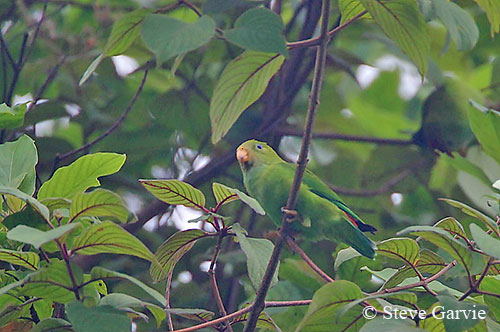
Juvenile
Brown eyes
RANGE:
The Sri Lanka Hanging Parrot is endemic to Sri Lanka. It is well distributed to the island up to about 1,200/1,600 metres of elevation. The species occurs mainly in the southern half of the island.
HABITAT:
The Sri Lanka Hanging Parrot is usually seen in low country and hilly areas.
It frequents wooded country, groves, plantations, orchards and coconut groves. But it prefers well wooded habitats, including forests.
The species is mainly found in the lower hills and the wet zone, and it is usually less common in dry areas close to the hills.
Outside the breeding season, it can be found at higher elevation.
CALLS AND SONGS: SOUNDS BY XENO-CANTO
In flight, the Sri Lanka Hanging Parrot gives a sharp “twit-twit-twit……….twit-twit-twit”. This call is also uttered while the bird is foraging.
When perched, it gives a series of squeaky, high-pitched, warbling notes “see”.
BEHAVIOUR IN THE WILD:
The Sri Lanka Hanging Parrot is often seen singly, in pairs or in small groups outside the breeding season.
It spends much time feeding in tree tops, delighting in juicy fruits, nectar of Erythrina (Coral Tree), Salmalia (Cotton Tree) and introduced Eucalypts. It also consumes seeds of Casuarina, fruits of Syzygium, flowers and fruits of cultivated bananas.
It shows a great affinity for the nectar of the Talipot Palm (Corypha umbraculifera).
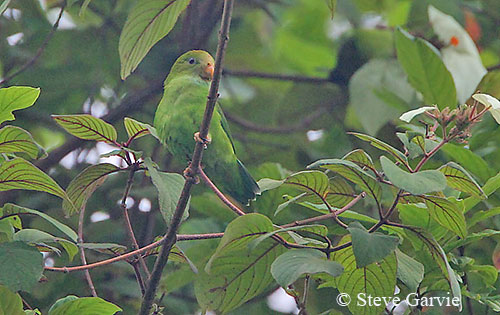
Juvenile
Brown eyes
It forages and feeds by scrambling along branches with great agility. The name “Hanging Parrot” is due to the habit of roosting and feeding with the head down, like bats.
It frequently visits orchards and gardens with fruiting trees. The species is strictly arboreal and rarely (or never) descends to the ground.
The Sri Lanka Hanging Parrot nests in tree hole or natural cavity in which the female brings plant material. The male remains close to the nest site, probably to protect her.
The species is resident endemic of the island. It only performs local movements related to food availability.
The Sri Lanka Hanging Parrot has swift and dashing flight, and it often flies quite high. The flight is usually undulating.
This species may fly considerable distances to find suitable feeding trees.
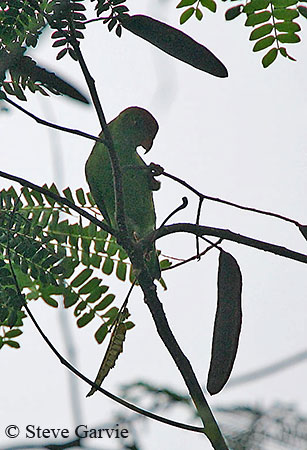
REPRODUCTION OF THIS SPECIES:
The breeding season takes place from January to August, with peak between March and May.
The Sri Lanka Hanging Parrot nests in natural cavity, often a hole in tree between two and twelve metres above the ground. The female alone builds the nest inside the hole. She brings nest material, usually strips of leaves, among her rump and wing feathers, although some of them probably fall off during the flight…
She builds the nesting cup at the bottom of the cavity, sometimes a metre deep.
She lays three chalky white eggs, but she usually incubates only two.
The female alone builds the nest and incubates the eggs.
More information is needed about the chick rearing.
